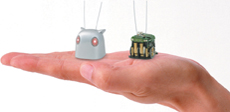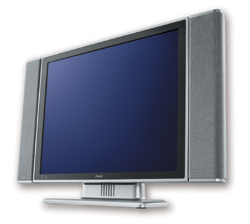The Pulse 2
Back to Contents of Issue: May 2003
|
|
|
|
by Daniel Scuka |
|
 Epson "Monsieur II" Robots
Launched at April's Robodex exhibition, these little guys are said to be the world's smallest and thinnest micro-actuator- and Bluetooth-equipped robot prototypes. Monsieur II's predecessor, "Monsieur" (no, really?), got into the Guinness Book of Records on account of its extreme tininess -- the new robots are smaller and better. No longer just moving around autonomously and a bit aimlessly, the M2s can now be radio-controlled via Bluetooth. They can pootle forward, pootle backward and turn left and right. And not necessarily at the same time. Sometimes they'll just turn left. Or just right. They're crazy little fellas like that. And they move at speeds of up to 70mm per second (Our brains are too small to work this out, but we believe this is close to about 100 mph in real money). Size-wise, the robots are less than 20mm all around and weigh 12.5 g, so they are probably not quite up to helping you with the housework. Maybe when they grow up.
Panasonic VDR-M30K I've wanted one of these since they were just twinkles in the eyes of smart engineers everywhere, and the better they get, the harder it is to write about them without getting real jealous. The VDR-M30K DVD player/recorder records onto 8 cm DVD-RAM and DVD-R discs, so you get the best of both worlds. Go for DVD-RAM if you want to keep adding and deleting stuff (Panny claims you can rewrite up to 100,000 times with DVD-RAM, which should take you up until you're about 137 years old) or opt for the "once-only" DVD-R discs and save some yen or cents in the process by using the cheaper media. Owners will be able to record up to 120 minutes of digital video and 1,998 still images to the DVD media. For a quick review, users can check out the thumbnails displayed on the 2.5-inch color LCD panel, and there's no need to fret about recording over images you've laid down previously because the M30K automatically finds space for you and starts recording there. No chance of taping the Super Bowl over your wedding video, then. The company also boasts about the machine's ability to do "nonlinear editing" of the footage you've taken while it's still there in the camcorder. Bye bye, expensive editing suites or peripherals. You can save still images onto an SD Memory Card, thanks to the special slot in the VDR-M30K, and there's a USB port for direct connection to your computer. More Info: www.prodb.matsushita.co.jp
Demand for Chaku-uta Exceeds Expectations IN BRIEF: Yuiichi Katoh, director of Label Mobile, told the Japanese media recently that demand for the company's chaku-uta music download service is much greater than originally expected. Katoh said that 20,000 to 30,000 songs are downloaded daily from the KDDI site and that the number of users with chaku-uta capable phones is now around 100,000. The service sells MP3 song fragments less than 30 seconds in length for JPY80 to JPY100 yen per song. Label Mobile was formed in July 2001 as a joint venture of several Japanese recording labels, including Avex, Sony Music Entertainment and Victor. The company's chaku-uta service is known as Record Gaisha Chokuei. When the service was launched in December, some industry insiders told us that it might be the next big thing in mobile content. Ringtones have been seeing stiff competition and dwindling subscriber numbers, and content providers were looking for something new to grab the keitai culture's imagination. While chaku-uta is similar to other MP3 download services, those services often require users to have special PHS devices to make it work. Chaku-uta can be downloaded onto regular cellphones such as Casio's A5302CA and Hitachi's A5303H. So far, it looks like chaku-uta is a hit.
Iiyama LCD Display Prolite C480T Now, your Iiyama ProLite C480T is basically a 19-inch SXGA LCD display with a built-in TV tuner. We've certainly seen a few of those recently. But Iiyama is a very well-respected PC peripheral manufacturer, and this product could very well turn out to be a heavy hitter. With a 1,280 x 1,024-dot display, 170-degree viewing angle, 600:1 contrast ratio and brightness of 430 cd/m2, the C480T is certainly no lightweight on the tech-specs scales. The response time is nice and fast at 25 ms and there are twin 5W speakers positioned either side of the screen. Sockets for input sources include one for a TV antenna, a D4, S-video, composite and DVI-I -- so that's pretty much all the input bases covered. The display looks the business and is at least as lovely looking as Sharp's very popular Aquos series (better looking, for my money), and you have the bonus of the high definition SXGA display thrown in. Iiyama has pictures of it hanging on a wall, much like the more expensive plasma displays, and it looks awesome. Priced at JPY159,800. More info: www.iiyama-sales.com/products/
Ricoh RDC-I700 Model G Surveyors all over the world will rejoice with the arrival of Ricoh's RDC-i700 because it is GPS conversant. Aimed at business users (we're thinking private eyes, professional explorers and garden gnome hunters), the i700 will take a photograph and, with the aid of the optional GPS card, work out the latitude and longitude of the spot the photo was taken and record that information with the image. The i700G has a 3,240,000-pixel CCD, so the photos these hardy boys will be able to take will be very decent, maxing out at 2,048 x 1,536 dots, and there's a 3x optical zoom for close-ups. If you care to lay down even more greenbacks (or, er, greybacks) and buy the optional communications card, the camera will also act, says Ricoh, as an "Internet terminal," allowing the sending of pictures over email, ftp uploading, viewing Web pages and the like. I would be more flippant, but Ricoh has envisaged all sorts of very serious and not at all hilarious applications for its new camera, including use by disaster agencies, with someone going out to a crash site, say, taking a pic and then having people back at the HQ operations room pinpoint the location of said crash site using mapping software on their PCs and so on. And the camera can record up to 10 seconds of audio too, making it even more useful. So, enough said. Price at JPY208,000. More info: www.ricoh.co.jp/
Cell-based Location Services on Target and Japan has Cheapest WLAN Darren Coleman, with Orange PCS (UK), said in an email in March that he was surprised to learn that J-Phone's new location service, Loco Guide, uses cell ID for location -- and not GPS (or some other, more accurate, technology). "Do you think there is any specific reason why J-Phone have not looked to enhance their location data accuracy? Are people happy enough with cell-ID-based accuracy as long as the quality of the mapping is good enough?" he asked. Basically, yes -- it appears that the non-GPS location services here (operated by NTT DoCoMo and J-Phone) work just fine with cell-based accuracy -- it's sufficient for consumer-focused, mass-market applications such as coupons, restaurants, nearest station or pub, etc. KDDI, of course, uses Qualcomm's GPS chip in their navi service, so accuracy is not an issue (although coverage inside buildings and time to connect to the satellites can cause frustration). Overall, all the mass-market navigation services here get lots of usage, so I think people are happy enough with them. Note that DoCoMo, for example, does offer GPS-based terminals for fleet applications. Darren also queried whether Japanese operators sell handsets on the back of specific services -- or are the GPS-based or cell-based location services marketed as a "generic part of the latest handsets?" He points out that, in Europe, most mobile players have invested in a variety of middleware platforms and location servers, but the next strategic decision is to improve accuracy -- and they can't define a clear business case for doing so. I told him that so far, Japanese carriers haven't really pushed location services as stand-alone products; they're sold as "part of" a handset, and there are no handsets that are sold only as, or primarily for, navi-service capabilities. Sure, KDDI did do a big marketing push when their first GPS-enabled keitai hit the market in December 2001, but now it's just one more feature onboard their fleet (in the January catalog, KDDI showed six of 11 handsets as having GPS capability). DoCoMo does sell one special device for tracking kids, elderly, and -- I guess -- errant spouses. The service is called: "Ima-Doco?" There are about 60,000 subscribers, and it works based on PHS, the cells of which are much smaller than on the mainline cellular network, so the accuracy is pretty good. Darren finished his mail asking, "For LBS in general, are services picking up in Japan?" Again, basically, yes. Location-based services are very popular and well-used. There are at least 80 content services on i-mode, EZweb, and J-Sky that use position data (games, maps, communication services, etc.), and there will be more on BREW. All in all, location services are popular and -- evidently -- profitable.
|
|
Note: The function "email this page" is currently not supported for this page.






